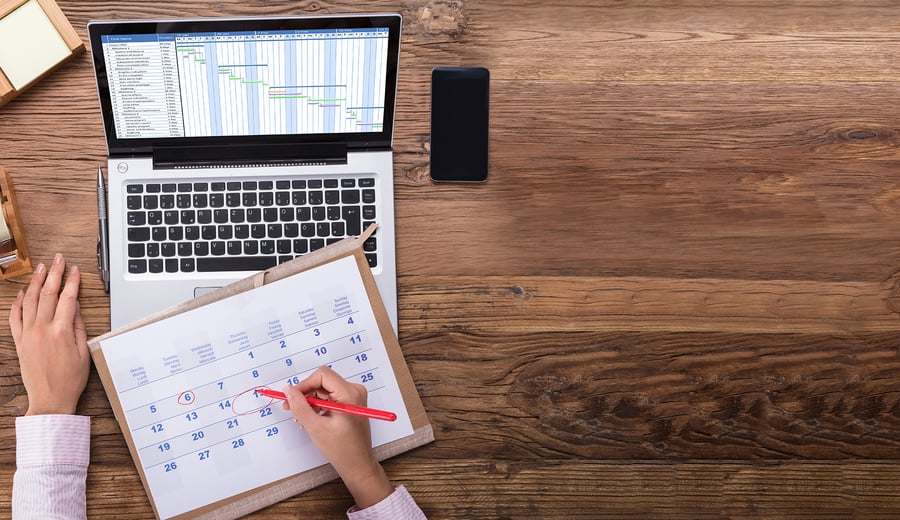Companies conduct business forecasts to determine their goals, targets, and project plans for each new period, whether quarterly, annually, or even 2–5 year planning.
Forecasting helps managers guide strategy and make informed decisions about critical business operations such as sales, expenses, revenue, and resource allocation. When done right, forecasting adds a competitive advantage and can be the difference between successful and unsuccessful companies.
In this guide to business forecasting, we'll cover:
- What is business forecasting?
- What are the best forecasting techniques?
- Why forecasting in management is important
- How to conduct business forecasts
- A few forecasting examples for businesses
An introduction to business forecasting
What is business forecasting? Business forecasting is a projection of future developments of a business or industry based on trends and patterns of past and present data.
This business practice helps determine how to allocate resources and plan strategically for upcoming projects, activities, and costs. Forecasting enables organizations to manage resources, align their goals with present trends, and increase their chances of surviving and staying competitive.
The purpose of forecasts is to develop better strategies and project plans using available, relevant data from the past and present to secure your business's future. Good business forecasting allows organizations to gain unique, proprietary insights into likely future events, leverage their resources, set product team OKR, and become market leaders.
Managers conduct careful and detailed business forecasts to guarantee sound decision-making based on data and logic, not emotions or gut feelings.
What are important business forecasting methods?
There are several business forecasting methods. They fall into two main approaches:
- Quantitative forecasting
- Qualitative forecasting
Quantitative and qualitative forecasting techniques use and provide different sets of data and are needed at different stages of a product's life cycle.
Note that significant changes in a company, such as new product focus, new competitors or competitive strategies, or changing compliance requirements diminish the connection between past and future trends. This makes choosing the right forecasting method even more important.
Quantitative business forecasting
Use quantitative forecasting when there is accurate past data available to analyze patterns and predict the probability of future events in your business or industry.
Quantitative forecasting extracts trends from existing data to determine the more probable results. It connects and analyzes different variables to establish cause and effect between events, elements, and outcomes. An example of data used in quantitative forecasting is past sales numbers.
Quantitative models work with data, numbers, and formulas. There is little human interference in quantitative analysis. Examples of quantitative models in business forecasting include:
- The indicator approach: This approach depends on the relationship between specific indicators being stable over time, e.g., GDP and the unemployment rate. By following the relationship between these two factors, forecasters can estimate a business's performance.
- The average approach: This approach infers that the predictions of future values are equal to the average of the past data. It is best to use this approach only when assuming that the future will resemble the past.
- Econometric modeling: Econometric modeling is a mathematically rigorous approach to forecasting. Forecasters assume the relationships between indicators stay the same and test the consistency and strength of the relationship between datasets.
- Time-series methods: Time-series methods use historical data to predict future outcomes. By tracking what happened in the past, forecasters expect to get a near-accurate view of the future.
Qualitative forecasting
Qualitative business forecasting is predictions and projections based on experts' and customers' opinions. This method is best when there is insufficient past data to analyze to reach a quantitative forecast. In these cases, industry experts and forecasters piece together available data to make qualitative predictions.
Qualitative models are most successful with short-term projections. They are expert-driven, bringing up contrasting opinions and reliance on judgment over calculable data. Examples of qualitative models in business forecasting include:
- Market research: This involves polling people – experts, customers, employees – to get their preferences, opinions, and feedback on a product or service.
- Delphi method: The Delphi method relies on asking a panel of experts for their opinions and recommendations and compiling them into a forecast.
How do you choose the right business forecasting technique?
- Choosing the right business forecasting technique depends on many factors. Some of these are:
- Context of the forecast
- Availability and relevance of past data
- Degree of accuracy required
- Allocated time to conduct the forecast
- Period to be forecast
- Costs and benefits of the forecast
- Stage of the product or business needing the forecast
Managers and forecasters must consider the stage of the product or business as this influences the availability of data and how you establish relationships between variables. A new startup with no previous revenue data would be unable to use quantitative methods in its forecast.
The more you understand the use, capabilities, and impact of different forecasting techniques, the more likely you will succeed in business forecasting.
Why is business forecasting important?
Any insight into the future puts your organization at an advantage. Forecasting helps you predict potential issues, make better decisions, and measure the impact of those decisions.
By combining quantitative and qualitative techniques, statistical and econometric models, and objectivity, forecasting becomes a formidable tool for your company.
Business forecasting helps managers develop the best strategies for current and future trends and events. Today, artificial intelligence, forecasting software, and big data make business forecasting easier, more accurate, and personalized to each organization.
Forecasting does not promise an accurate picture of the future or how your business will evolve, but it points in a direction informed by data, logic, and experiential reasoning.
What are the integral elements of business forecasting?
While there are different forecasting techniques and methods, all forecasts follow the same process on a conceptual level. Standard elements of business forecasting include:
- Prepare the stage: Before you begin, develop a system to investigate the current state of business.
- Choose a data point: An example for any business could be "What is our sales projection for next quarter?"
- Choose indicators and data sets: Identify the relevant indicators and data sets you need and decide how to collect the data.
- Make initial assumptions: To kickstart the forecasting process, forecasters may make some assumptions to measure against variables and indicators.
- Select forecasting technique: Pick the technique that fits your forecast best.
- Analyze data: Analyze available data using your selected forecasting technique.
- Estimate forecasts: Estimate future conditions based on data you've gathered to reach data-backed estimates.
- Verify forecasts: Compare your forecast to the eventual results. This helps you identify any problems, tweak errant variables, correct deviations, and continue to improve your forecasting technique.
- Review forecasting process: Review any deviations between your forecasts and actual performance data.
How do you do business forecasting?
Successful business forecasting begins with a collaboration between the manager and forecaster. They work together to answer the following questions:
- What is the purpose of the forecast? How will it be used?
- What are the components and dynamics of the system the forecast is focused on?
- How relevant is past data in estimating the future?
Once these answers are clear, choose the best forecasting methods based on the stage of the product or business life cycle, availability of past data, and skills of the forecasters and managers leading the project.
With the right forecasting method, you can develop your process using the integral elements of business forecasting mentioned above.
How do you get data for business forecasting?
A forecast is only as good as the data supplied. Before collecting data, ask:
- Why do you need it?
- What kind of data do you need?
- When will you collect it?
- Where will you gather it?
- Who is in charge of collecting it?
- How will you collect it?
- How will you analyze it?
When you have these answers, you can start collecting data from two main sources:
- Primary sources: These sources are gathered first-hand using reporting tools — you or members of your team source data through interviews, surveys, research, or observations.
- Secondary sources: Secondary sources are second-hand information or data that others have collected. Examples include government reports, publications, financial statements, competitors' annual reports, journals, and other periodicals.
Business forecasting examples
Some forecasting examples for business include:
- Calculating cash flow forecasts, i.e., predicting your financial needs within a timeframe
- Estimating the threat of new entrants into your market
- Measuring the opportunity of developing a new product or service
- Estimating the costs of recurring bills
- Predicting future sales growth based on past sales performance
- Analyzing relationships between variables, e.g., Facebook ads and potential revenue
- Budgeting contingencies and efficient allocation of resources
- Comparing customer acquisition costs and customer lifetime value over time
What are the limits of business forecasting?
You can follow the rules, use the right methods, and still get your business forecast wrong. It is, after all, an attempt to predict the future. Some limits to business forecasting include:
- Biases and errors by the forecasters or managers
- Incorrect information from employees, experts, or customers
- Inaccurate past numbers
- Sudden change in market conditions
- New industry regulations
How Wrike helps with business forecasting
The more accurate your business forecasting, the more effective your strategies and plans can be. While many things in business are out of your control, having an informed forecast of what lies ahead makes you prepared and confident about the future.
Wrike helps gather data in one central platform, extract insights, and communicate findings with forecasters and managers. Other benefits of Wrike include real-time data, integrations with other forecasting software, streamlined collaboration, and visibility into every business forecasting project.
Are you ready to make projections for your business, allocate your resources for the best results, and improve your business forecasting process? Get started with a two-week free trial of Wrike today.







